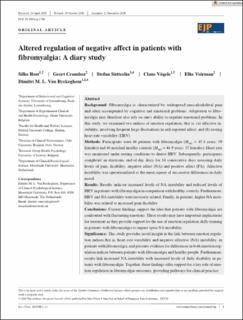| dc.description.abstract | Background: Fibromyalgia is characterized by widespread musculoskeletal painand often accompanied by cognitive and emotional problems. Adaptation to fibromyalgia may therefore also rely on one's ability to regulate emotional problems. In this study, we examined two indices of emotion regulation, that is, (a) affective instability, involving frequent large fluctuations in self-reported affect, and (b) resting heart rate variability (HRV).
Methods: Participants were 46 patients with fibromyalgia (Mage = 45.4 years; 39 females) and 46 matched healthy controls (Mage = 44.9 years; 37 females). Heart rate was monitored under resting conditions to derive HRV. Subsequently, participants completed an electronic end-of-day diary for 14 consecutive days assessing daily levels of pain, disability, negative affect (NA) and positive affect (PA). Affective instability was operationalized as the mean square of successive differences in daily mood.
Results: Results indicate increased levels of NA instability and reduced levels of HRV in patients with fibromyalgia in comparison with healthy controls. Furthermore, HRV and NA instability were inversely related. Finally, in patients, higher NA instability was related to increased pain disability.
Conclusions: Current findings support the idea that patients with fibromyalgia are confronted with fluctuating emotions. These results may have important implications for treatment as they provide support for the use of emotion regulation skills training in patients with fibromyalgia to impact upon NA instability.
Significance: This study provides novel insight in the link between emotion regulation indices,that is, heart-rate variability and negative affective (NA) instability, in patients with fibromyalgia, and presents evidence for differences in both emotion regulation indices between patients with fibromyalgia and healthy people. Furthermore, results link increased NA instability with increased levels of daily disability in patients with fibromyalgia. Together, these findings offer support for a key role of emotion regulation in fibromyalgia outcomes, providing pathways for clinical practice. | en_US |

